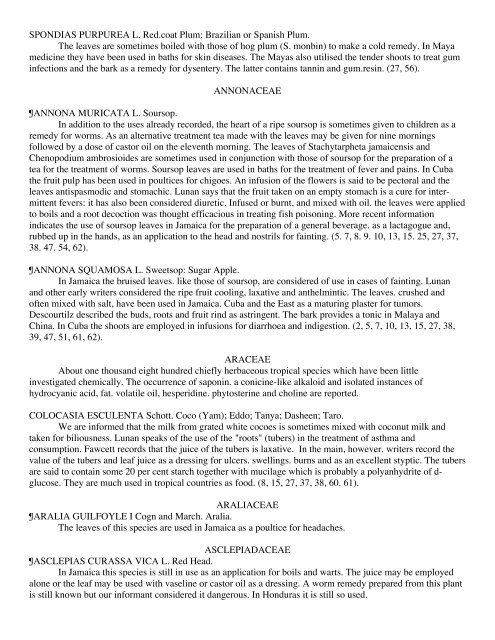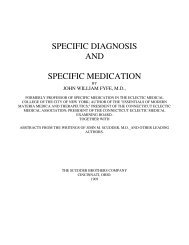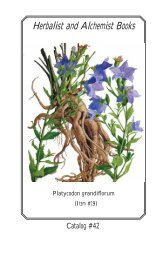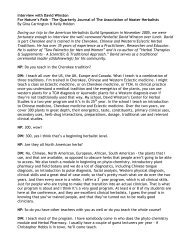MEDlCINAL PLANTS OF JAMAICA. PARTS 1 & 11.
MEDlCINAL PLANTS OF JAMAICA. PARTS 1 & 11.
MEDlCINAL PLANTS OF JAMAICA. PARTS 1 & 11.
Create successful ePaper yourself
Turn your PDF publications into a flip-book with our unique Google optimized e-Paper software.
SPONDIAS PURPUREA L. Red.coat Plum: Brazilian or Spanish Plum.<br />
The leaves are sometimes boiled with those of hog plum (S. monbin) to make a cold remedy. In Maya<br />
medicine they have been used in baths for skin diseases. The Mayas also utilised the tender shoots to treat gum<br />
infections and the bark as a remedy for dysentery. The latter contains tannin and gum.resin. (27, 56).<br />
ANNONACEAE<br />
ANNONA MURICATA L. Soursop.<br />
In addition to the uses already recorded, the heart of a ripe soursop is sometimes given to children as a<br />
remedy for worms. As an alternative treatment tea made with the leaves may be given for nine mornings<br />
followed by a dose of castor oil on the eleventh morning. The leaves of Stachytarpheta jamaicensis and<br />
Chenopodium ambrosioides are sometimes used in conjunction with those of soursop for the preparation of a<br />
tea for the treatment of worms. Soursop leaves are used in baths for the treatment of fever and pains. In Cuba<br />
the fruit pulp has been used in poultices for chigoes. An infusion of the flowers is said to be pectoral and the<br />
leaves antispasmodic and stomachic. Lunan says that the fruit taken on an empty stomach is a cure for intermittent<br />
fevers: it has also been considered diuretic. Infused or burnt, and mixed with oil. the leaves were applied<br />
to boils and a root decoction was thought efficacious in treating fish poisoning. More recent information<br />
indicates the use of soursop leaves in Jamaica for the preparation of a general beverage. as a lactagogue and,<br />
rubbed up in the hands, as an application to the head and nostrils for fainting. (5. 7, 8. 9. 10, 13, 15. 25, 27, 37,<br />
38. 47. 54, 62).<br />
ANNONA SQUAMOSA L. Sweetsop: Sugar Apple.<br />
In Jamaica the bruised leaves. like those of soursop, are considered of use in cases of fainting. Lunan<br />
and other early writers considered the ripe fruit cooling, laxative and anthelmintic. The leaves. crushed and<br />
often mixed with salt, have been used in Jamaica. Cuba and the East as a maturing plaster for tumors.<br />
Descourtilz described the buds, roots and fruit rind as astringent. The bark provides a tonic in Malaya and<br />
China. In Cuba the shoots are employed in infusions for diarrhoea and indigestion. (2, 5, 7, 10, 13, 15, 27, 38,<br />
39, 47, 51, 61, 62).<br />
ARACEAE<br />
About one thousand eight hundred chiefly herbaceous tropical species which have been little<br />
investigated chemically. The occurrence of saponin. a conicine-like alkaloid and isolated instances of<br />
hydrocyanic acid, fat. volatile oil, hesperidine. phytosterine and choline are reported.<br />
COLOCASIA ESCULENTA Schott. Coco (Yam); Eddo; Tanya; Dasheen; Taro.<br />
We are informed that the milk from grated white cocoes is sometimes mixed with coconut milk and<br />
taken for biliousness. Lunan speaks of the use of the "roots" (tubers) in the treatment of asthma and<br />
consumption. Fawcett records that the juice of the tubers is laxative. In the main, however. writers record the<br />
value of the tubers and leaf juice as a dressing for ulcers. swellings. burns and as an excellent styptic. The tubers<br />
are said to contain some 20 per cent starch together with mucilage which is probably a polyanhydrite of dglucose.<br />
They are much used in tropical countries as food. (8, 15, 27, 37, 38, 60. 61).<br />
ARALIACEAE<br />
ARALIA GUILFOYLE I Cogn and March. Aralia.<br />
The leaves of this species are used in Jamaica as a poultice for headaches.<br />
ASCLEPIADACEAE<br />
ASCLEPIAS CURASSA VICA L. Red Head.<br />
In Jamaica this species is still in use as an application for boils and warts. The juice may be employed<br />
alone or the leaf may be used with vaseline or castor oil as a dressing. A worm remedy prepared from this plant<br />
is still known but our informant considered it dangerous. In Honduras it is still so used.







